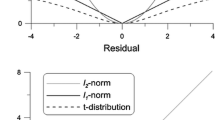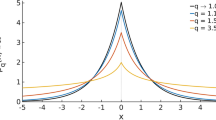Abstract
The wavefield in the Laplace domain has a very small amplitude except only near the source point. In order to deal with this characteristic, the logarithmic objective function has been used in many Laplace domain inversion studies. The Laplace-domain waveform inversion using the logarithmic objective function has fewer local minima than the time- or frequency domain inversion. Recently, the power objective function was suggested as an alternative to the logarithmic objective function in the Laplace domain. Since amplitudes of wavefields are very small generally, a power <1 amplifies the wavefields especially at large offset. Therefore, the power objective function can enhance the Laplace-domain inversion results. In previous studies about synthetic datasets, it is confirmed that the inversion using a power objective function shows a similar result when compared with the inversion using a logarithmic objective function. In this paper, we apply an inversion algorithm using a power objective function to field datasets. We perform the waveform inversion using the power objective function and compare the result obtained by the logarithmic objective function. The Gulf of Mexico dataset is used for the comparison. When we use a power objective function in the inversion algorithm, it is important to choose the appropriate exponent. By testing the various exponents, we can select the range of the exponent from 5 × 10−3 to 5 × 10−8 in the Gulf of Mexico dataset. The results obtained from the power objective function with appropriate exponent are very similar to the results of the logarithmic objective function. Even though we do not get better results than the conventional method, we can confirm the possibility of applying the power objective function for field data. In addition, the power objective function shows good results in spite of little difference in the amplitude of the wavefield. Based on these results, we can expect that the power objective function will produce good results from the data with a small amplitude difference. Also, it can partially be utilized at the sections where the amplitude difference is very small.











Similar content being viewed by others
References
Abubakar, A., Li, M., Liu, J., and Habashy, T.M. (2011), Application of the compressed implicit jacobian scheme for elastic full waveform inversion, In Expanded Abstracts, EAGE.
Bae, H.S., Shin, C., Cha, Y.H., Choi, Y., and Min, D.J. (2010), 2D acoustic-elastic coupled waveform inversion in the Laplace domain, Geophysical Prospecting 58, 997–1010.
Bunks, C., F.M. Saleck, S. Zaleski and G. Chavent. (1995), Multiscale seismic waveform inversion, Geophysics 60, 1457–1473.
Chung, W., Shin, C., and Pyun, S. (2010), 2D Elastic Waveform inversion in the Laplace Domain, Bulletin of the Seismological Society of America 100, No. 6, 3239–3249.
Geller, R.J., and T., Hara. (1993), Two efficient algorithms for iterative linearized inversion of seismic waveform data, Geophysical Journal International 115, 699–710.
Ha, T., Chung, W., and Shin, C. (2009), Waveform inversion using a back-propagation algorithm and a Huber function norm, Geophysics 74, R15–R24.
Lailly, P., (1983) The seismic inverse problem as a sequence of before stack migrations., In: Conference on Inverse Scattering: Theory and Application (SIAM, Philadelphia 1983).
Levenberg, K. (1994), A method for the solution of certain nonlinear problems in least squares, Quarterly Journal of Applied Mathematics 2, 164–168.
Marquardt, D.W. (1963), An algorithm for least squares estimation of non-linear parameters, Journal of the Society of Industrial and Applied Mathematics 11, 431–441.
Métivier, L., Brossier, R., Virieux, J., and Operto, S. (2012), Toward gauss-newton and exact newton optimization for full waveform inversion, In EAGE, 74th Conference and Exhibition, P016.
Mora, P. (1987), Nonlinear two-dimensional elastic inversion of multioffset seismic data, Geophysics 52, 1211–1228.
Operto, S., Ravaut, C., Improta, L., Virieux, J., Herrero, A., and Dell’Aversana, P. (2004), Quantitative imaging of complex structures from dense wide-aperture seismic data by multiscale traveltime and waveform inversions: A case study, Geophysical Prospecting 52, 625–651.
Pratt, R.G. (1999), Seismic waveform inversion in frequency domain—Part 1: Theory and verification in physical scale model, Geophysics 64, 888–901.
Pratt, R.G., Shin, C., and Hicks, G.J. (1998), Gauss-Newton and full Newton methods in frequency-space seismic waveform inversion, Geophysical Journal International 133, 341–362.
Pyun, S., Son, W., and Shin, C. (2011), 3D acoustic waveform inversion in the Laplace domain using an iterative solver, Geophysical Prospecting 59, 386–399.
Shin, C., and Cha, Y.H. (2008), Waveform inversion in the Laplace domain, Geophysical Journal International 173, 922–931.
Shin, C., and Cha, Y.H. (2009), Waveform inversion in the Laplace-Fourier domain, Geophysical Journal International 177, No. 3, 1067–1079.
Shin, C., and Ha, W. (2008), A comparison between the behavior of objective functions for waveform inversion in the frequency and Laplace domains, Geophysics 73, No. 5, VE119–VE133.
Shin, C., and Min, D.J. (2006), Waveform inversion using a logarithmic wavefield, Geophysics 71, R31–R42.
Shin, C., Jang, S., and Min, D.J. (2001), Improved amplitude preservation for prestack depth migration by inverse scattering theory, Geophysical Prospecting 49, 592–606.
Shin, C., Pyun, S., and Bednar, J.B. (2007), Comparison of waveform inversion., part 1: conventional wavefield vs logarithmic wavefield, Geophysical Prospecting 55, 449–464.
Shipp, R.M., and Singh, S.C. (2002), Two-dimensional full wavefield inversion of wide-aperture marine seismic streamer data, Geophysical Journal International 151, 325–344.
Symes, W.W. (2008), Migration velocity analysis and waveform inversion, Geophysical Prospecting 56, 765–790.
Tarantola, A. (1984), Inversion of seismic reflection data in the acoustic approximation, Geophysics 49, 1259–1266.
Acknowledgments
This work was supported financially by the Energy Efficiency & Resources (No. 2010T100200376) and Human Resources Development program (No. 20124010203200) of the Korea Institute of Energy Technology Evaluation and Planning (KETEP) grant funded by the Korea government Ministry of Knowledge Economy. We thank GX Technology for providing us with the field data.
Author information
Authors and Affiliations
Corresponding author
Rights and permissions
About this article
Cite this article
Park, E., Ha, W., Chung, W. et al. 2D Laplace-Domain Waveform Inversion of Field Data Using a Power Objective Function. Pure Appl. Geophys. 170, 2075–2085 (2013). https://doi.org/10.1007/s00024-013-0651-4
Received:
Revised:
Accepted:
Published:
Issue Date:
DOI: https://doi.org/10.1007/s00024-013-0651-4




